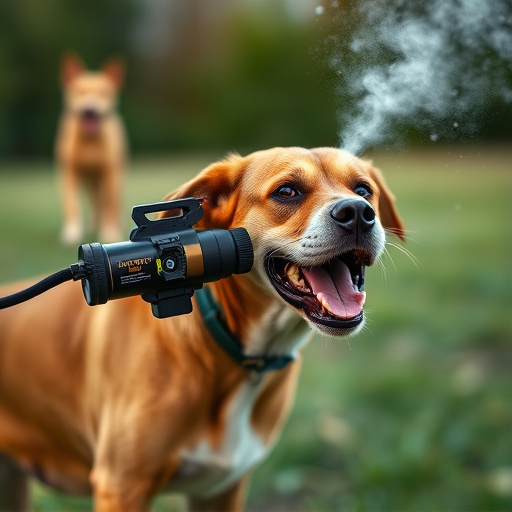Understanding animal control spray laws and regulations is crucial before learning mace spray techniques. Each region has unique rules regarding possession, carrying, and using these devices, which should only be employed in specific high-risk situations involving aggressive animals. Training sessions teach spray types, safe handling, application methods, de-escalation techniques, and local legal requirements to ensure public safety and comply with regulations. After a pepper spray deployment, proper aftercare involves securing individuals, seeking medical help if needed, and rinsing eyes and skin for 15 minutes without friction. Unauthorized use can result in fines or legal repercussions, so consulting a legal professional is essential.
Animal control spray, also known as pepper spray, is a powerful tool used for self-defense against aggressive animals. Understanding its legal use and handling procedures is crucial for responsible deployment. This article guides you through the intricacies of animal control spray laws, identifying suitable scenarios for its application, learning safe handling practices, and managing aftercare and legal considerations when using mace spray techniques effectively.
- Understanding Animal Control Spray Laws and Regulations
- Identifying Appropriate Situations for Legal Use of Pepper Spray
- Proper Handling and Safety Measures When Using Animal Control Spray
- Aftercare and Legal Considerations Following Pepper Spray Deployment
Understanding Animal Control Spray Laws and Regulations
Understanding Animal Control Spray Laws and Regulations is a crucial step before learning how to practice mace spray techniques. Each jurisdiction has its own set of rules governing the use of animal control or mace spray, so it’s essential to familiarize yourself with your local laws. These regulations dictate who can possess and carry such devices, where they can be used, and under what circumstances. For instance, some areas may permit their use only for specific types of animals, like aggressive dogs, while others might restrict their application to emergency situations or when authorized by a licensed professional.
To ensure legal compliance, consider attending workshops or training sessions that educate you on these laws. You’ll learn about the different types of animal control sprays available, their safe handling and application methods, as well as de-escalation techniques. Understanding when and how to use these tools responsibly not only helps maintain public safety but also fosters a positive relationship between humans and animals.
Identifying Appropriate Situations for Legal Use of Pepper Spray
When considering the legal use of animal control spray, also known as mace spray, it’s paramount to understand that its deployment is subject to specific regulations and should only be employed in appropriate situations. These situations typically involve scenarios where an individual’s safety or property is at risk from aggressive animals, such as hostile dogs or wild creatures. Before resorting to spray, individuals must assess the threat level and ensure there are no other reasonable alternatives for de-escalation or escape.
Identifying the right moment to use mace spray requires awareness and skill. It’s crucial to learn how to properly handle and aim the device, ensuring that you target specific areas like the animal’s face or eyes to minimize harm to others or pets in the vicinity. Proper training in mace spray techniques allows users to make informed decisions, react quickly, and use the spray effectively while adhering to local laws and regulations.
Proper Handling and Safety Measures When Using Animal Control Spray
When using animal control spray, or mace, proper handling and safety measures are paramount. Always read and understand the product label before use, as different sprays may have specific guidelines. Wear protective gear, including gloves and eye protection, to minimize exposure to the spray. Ensure good ventilation in the area where you will be applying the spray, as respiratory irritation can occur. Hold the canister firmly and aim it away from yourself and others while pressing the trigger slowly and smoothly. Never point the spray at anyone, even if they are causing trouble, as unintended targets can suffer adverse effects.
After use, wash your hands thoroughly with soap and water to remove any residual spray. Store the canister in a cool, dry place, out of reach of children and pets. Familiarize yourself with local laws regarding the use of animal control spray, as regulations vary significantly from one region to another. In many places, there are restrictions on where and when you can use such sprays, so it’s crucial to stay informed to avoid legal complications. Learn how to practice mace spray techniques safely and responsibly to ensure effective control while minimizing risks.
Aftercare and Legal Considerations Following Pepper Spray Deployment
After a pepper spray deployment, proper aftercare is essential to ensure the safety and well-being of all involved. Those affected by the spray should be moved to a safe, open area away from potential hazards. Medical attention should be sought immediately if breathing difficulties, severe pain, or any unusual symptoms occur. The eyes and skin must be thoroughly rinsed with water for at least 15 minutes, and individuals should avoid rubbing or scratching the affected areas.
Legally, the use of pepper spray or mace is regulated and varies by jurisdiction. It’s crucial to understand local laws and obtain necessary permits before deploying such agents. In many places, it is only permitted for self-defense or law enforcement purposes, and unauthorized use can result in fines or legal consequences. Always consult with a legal professional to ensure compliance and know your rights when employing Mace spray techniques.
Knowing the legal use of animal control spray, identifying appropriate situations, understanding safety measures, and considering aftercare are crucial aspects of practicing mace spray techniques responsibly. By adhering to these guidelines, individuals can ensure they remain within legal boundaries while protecting themselves or their property. Proper handling and informed decision-making are key to effective and safe deployment, fostering a harmonious coexistence with our animal neighbors.
